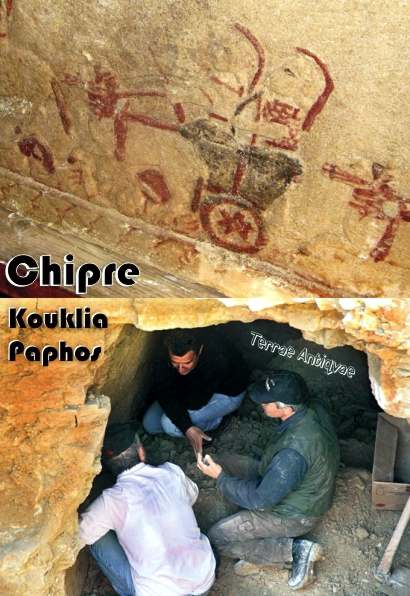Descubierto en Chipre un sarcófago de 2.500 años de antigüedad con escenas en color de los poemas épicos de Homero

Foto: (1) One of the illustrations on the coffin shows two warriors on a chariot. Akis Ethelondis / AP (2) People work in the ancient tomb in Kouklia village near the coastal town of Paphos, Cyprus, where the white-stone sarcophagus was found. Andreas Lazarou / AP
Un sarcófago de 2.500 años de antigüedad con ilustraciones en color de los poemas épicos de Homero ha sido descubierto en el oeste de Chipre, según señaló hoy un equipo de arqueólogos.
"Es un hallazgo muy importante. El estilo de la decoración es único, no tanto desde el punto de vista artístico, sino por el tema y los colores usados", señaló el director del departamento de antigüedades de la isla, Pavlos Flourentzos.
Sólo otros dos sarcófagos similares han sido descubiertos previamente en Chipre. Ambos se hallan en el Museo Metropolitano de Arte, en Nueva York, pero los colores usados en la decoración son menos intensos.
El sarcófago, de piedra caliza, fue descubierto de manera accidental por obreros de la construcción la semana pasada en una tumba cercana a la aldea de Kouklia, en el distrito costero de Paphos. La tumba, que posiblemente perteneció a un antiguo guerrero, había sido saqueada durante la antigüedad.
Flourentzos informó de que el ataúd --pintado en rojo, negro y azul, con un fondo blanco-- databa del año 500 antes de Cristo, cuando la cultura griega adquirió influencia en esta isla del este del Mediterráneo. "El estilo es muy simple. Tiene poco que ver con ulteriores normas y prototipos clásicos", indicó Flourentzos.
Los expertos creen que las decoraciones muestran al héroe Ulises en escenas de la Ilíada y la Odisea de Homero, ambos poemas inmensamente populares en el mundo colonizado por los griegos.
En una de las pinturas, Ulises y sus camaradas huyen de la cueva del cíclope Polifemo ocultos entre una manada de ovejas. Otra pintura muestra una batalla entre griegos y troyanos, tomada de la Ilíada.
Los arqueólogos creen que las escenas sugieren el status del ocupante del ataúd. "¿Por qué tomar esas dos piezas de Homero y por qué aparece Ulises?", se preguntó Flourentzos. "Tal vez eso representa el carácter del muerto, que era posiblemente un guerrero", añadió.
Fuente: Europa Press / AP / NICOSIA, 20 marzo de 2006
Enlace: http://www.europapress.es/europa2003/
noticia.aspx?cod=20060320170740&tabID=1&ch=69
-------------------------------------
(2) Coffin with scenes from Homer's epics found 2,500-year-old sarcophagus unearthed in Cyprus
NICOSIA, Cyprus - A 2,500-year-old stone coffin with well-preserved color illustrations from Homer's epics has been discovered in western Cyprus, archaeologists said Monday.
"It is a very important find," said Pavlos Flourentzos, director of the island's antiquities department. "The style of the decoration is unique, not so much from an artistic point of view, but for the subject and the colors used."
Only two other similar sarcophagi have ever been discovered in Cyprus before. One is housed in New York's Metropolitan Museum of Art and the other in the British Museum in London, but their color decoration is more faded, Flourentzos said.
The limestone sarcophagus was accidentally found by construction workers last week in a tomb near the village of Kouklia, in the coastal Paphos area. The tomb, which probably belonged to an ancient warrior, had been looted during antiquity.
Flourentzos said the coffin painted in red, black and blue on a white background dated to 500 B.C., when Greek cultural influence was gaining a firm hold on the eastern Mediterranean island. Pottery discovered in the tomb is expected to provide a precise date.
"The style is very simple, it has little to do with later Classical prototypes and rules," Flourentzos said.
Experts believe the ornate decoration features the hero Ulysses in scenes from Homer's Iliad and Odyssey both hugely popular throughout the Greek world.
In one large painting, Ulysses and his comrades escape from the blind Cyclops Polyphemos' cave, hidden under a flock of sheep.
Another depicts a battle between Greeks and Trojans from the Iliad.
"Ulysses known for his archery skills is taking on a whole army emerging from the gates of Troy on horseback and in chariots," Flourentzos said.
Archeologists think the scenes hint at the status of the coffin's occupant.
"Why else take these two pieces from Homer and why deal with Ulysses? Maybe this represents the dead person's character who possibly was a warrior," Flourentzos said.
Other drawings depict a figure carrying a seriously injured or dead man and a lion fighting a wild boar under a tree. These are not believed to be linked with Homer's poems.
Reflecting a long oral tradition loosely based on historic events, Homer's epics were probably composed around 800 B.C. and written down in the 6th century B.C.
The tomb was found in an area containing several ancient cemeteries which belonged to the nearby town of Palaepaphos, some 18 kilometers (11 miles) inland from modern Paphos.
First settled around 2800 B.C., Palaepaphos was the site of a temple of Aphrodite the ancient goddess of beauty who, according to mythology, was born in the sea off Paphos.
The temple was one of the ancient world's most famous cult places and remained in use until early Christian times, in the 4th century.
Fuente: Copyright 2006 The Associated Press, 20 de marzo de 2006
Enlace: http://msnbc.msn.com/id/11928232/
0 comentarios